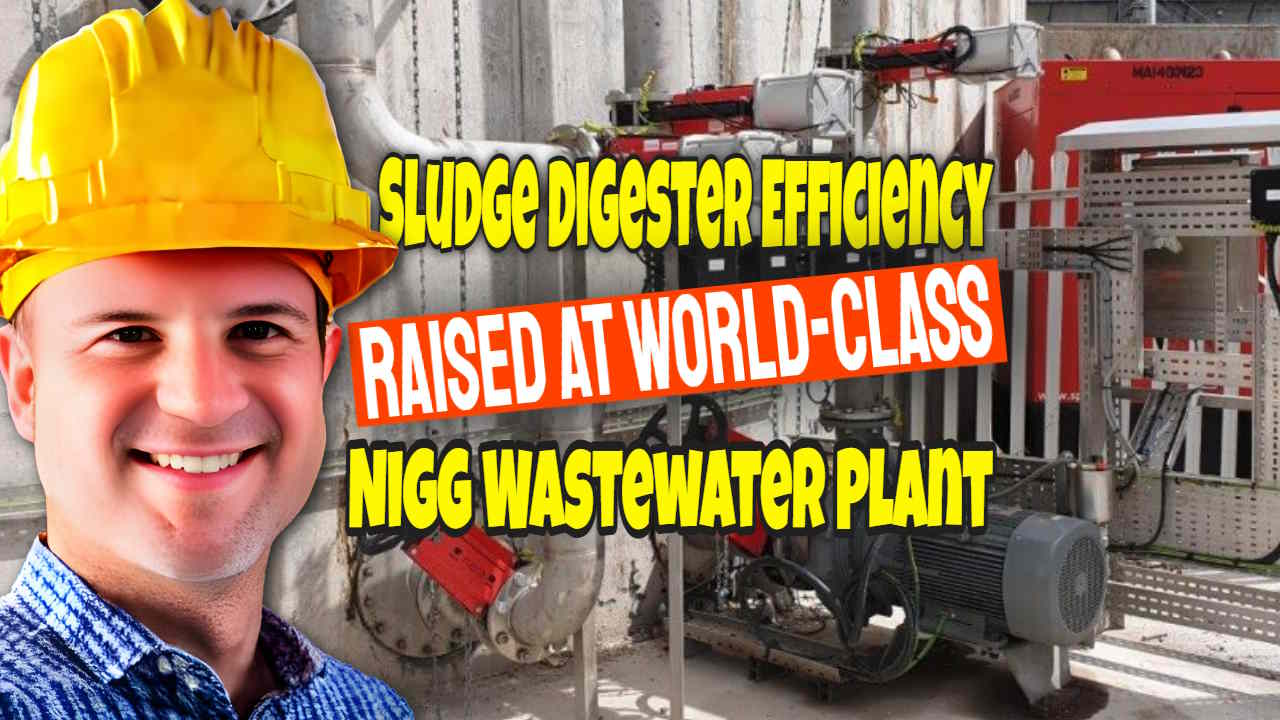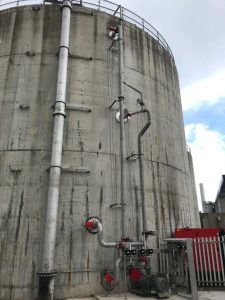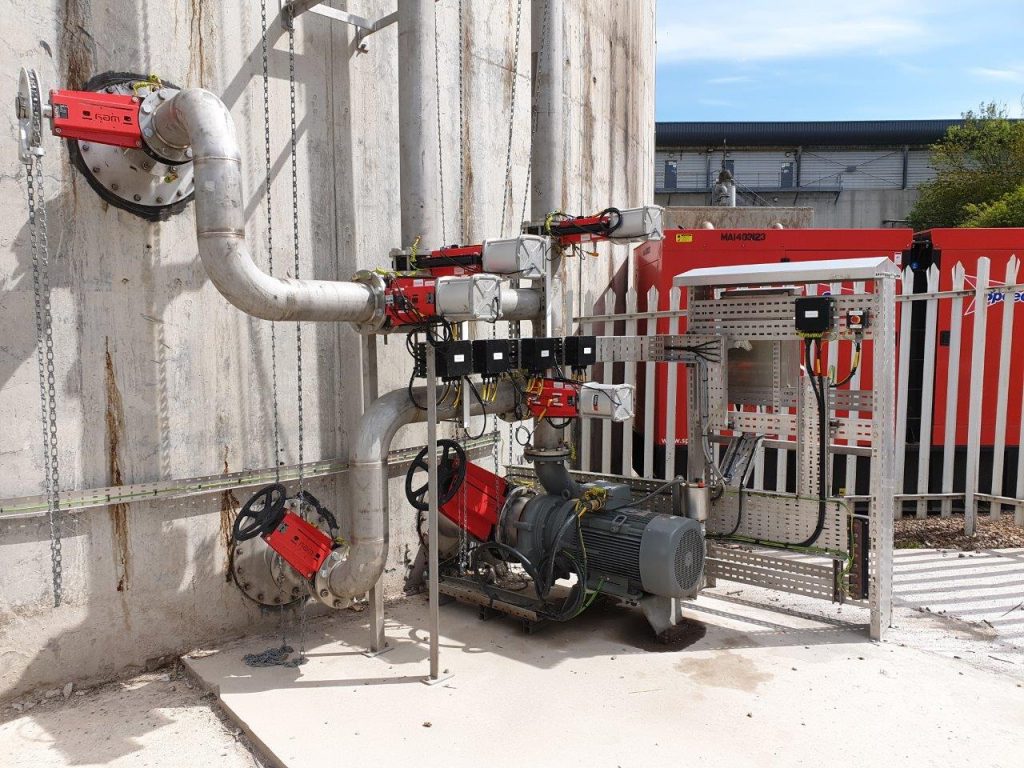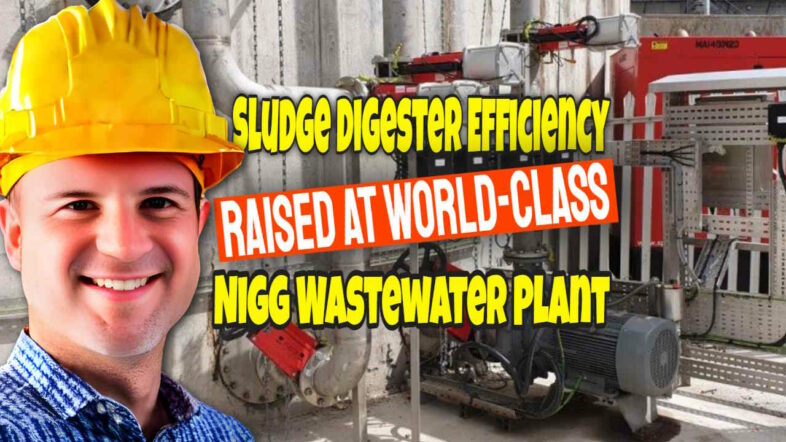Sludge Digesters are being used increasingly by water utility companies, and they can be important as energy providers in these times of high nonrenewable energy prices, so the fact that sludge digester efficiency has been raised significantly at a Wastewater Plant is significant. Scroll down to see the original Press Release from May 2019.
A sludge digester (sludge digestion facility) is a popular term used by many for an anaerobic digestion plant which is used for sewage sludge treatment.
In this article, we explain how the UK leads the way globally in sludge digestion technology. And in particular, how one advanced sludge AD Plant in Scotland has a further improved sludge digester efficiency through a retrofit of the Landia GasMix tank mixing system.
What is Sewage Sludge Treatment?
Sewage sludge treatment describes the processes used to manage and dispose of sewage sludge produced during sewage treatment. Sludge is mostly wastewater with lesser amounts of solid material removed from liquid sewage. Primary sludge includes settleable solids removed during primary treatment in primary clarifiers. Secondary sludge separated in secondary clarifiers includes treated sewage sludge from secondary treatment bioreactors.
Sludge treatment is focused on reducing sludge weight and volume to reduce disposal costs, and on reducing potential health risks of disposal options. Water removal is the primary means of weight and volume reduction, while pathogen destruction is frequently accomplished through heating during thermophilic digestion, composting, or incineration. via en.wikipedia.org

The Need for Sludge Digester Efficiency
Energy may be recovered from sludge through methane gas produced during anaerobic digestion, but sludge does not release its energy easily.
In fact, energy yield can be low unless biogas is produced skillfully and well-optimized. It can even be insufficient to evaporate sludge water content, or even to power the blowers, pumps, or centrifuges required for sludge dewatering.
In the US, and notably in California where some of the earliest AD Plants based upon the current technology, were built for sludge digestion it is still considered that huge plants are necessary. Economies of scale are thought to be essential for success in terms of biogas plant efficiency. And, thus to make them economically viable it can only be done at a very large scale:
“In the very large metropolitan areas of southern California inland communities return sewage sludge to the sewer system of communities at lower elevations to be reprocessed at a few very large treatment plants on the Pacific coast.” via en.wikipedia.org
How UK Sludge Digester Efficiency is Beating the US and Proving it can be done at Smaller Scale Plants
Despite this, UK Water Companies are successfully treating their sewage sludge. And, they are doing it in digesters a fraction of the size of those of US counterparts using organic processes. Plants much smaller than US digesters, each one of which caters to many millions of residents in large conurbations of the US West Coast.
Not only that but a number of recent UK sewage sludge digesters have been stated to power, up-to half the total electricity demand of the entire sewage works to which they are attached. This of course helps to reduce climate change by reducing the use of non-renewable power. Improved sludge digester efficiency also saves on the otherwise huge burden of power costs, at wastewater treatment works.
The Nigg WwTW Example of High Sludge Digester Efficiency

Nigg WwTW located to the southeast of the City of Aberdeen on the shore of Nigg Bay serves a PE (population equivalent) of 250,000 people and receives sewage sludge from a further 200,000. It is operated by Kelda Water Services Grampian (KWS Grampian) in conjunction with Scottish Water.
“After reception and blending, sludges are dewatered and thickened, with the assistance of polymer addition, and pre-treated by thermal hydrolysis before entering 2 (No.) anaerobic digesters with a combined heat and power system. Digested sludge is then dewatered, assisted by further polymer addition, with the resulting product applied to land.”
via www.waterprojectsonline.com
“Ongoing programmes of sludge digester efficiency optimization”
It is known that Scottish Water and KWS Grampian have a continuing programme of optimization at their treatment plants and AD facilities to achieve a further reduction in carbon emissions and operating costs.
Therefore, we are delighted to be able to relay the following Landia Press Release:
Press Release:
New Sludge Digester Retrofit by Landia for Scottish Water

Landia has won an important new order with Scottish Water to retrofit two sludge digesters with its acclaimed high sludge digester efficiency GasMix mixing systems.
Two partly underground cast-in-situ digesters (17m by 20m) at Nigg near Aberdeen will now be served by the externally-mounted GasMix – designed for easy maintenance and greatly improved gas yields. All parts of the system are removable from the outside of the tank. The previous mixing system was problematic and underperforming.
“diametrically opposite Landia chopper pumps”
Each digester at Nigg will be fitted with two diametrically opposite Landia chopper pumps (Landia can retrofit steel or concrete tanks), which draw thick liquid from the bottom of the tank, where solids are chopped to accelerate the digestion process and prevent clogging of pipes and nozzles.
In the first stage of the mixing process, the liquid will be injected into the upper half of the tank, while biogas is aspirated from the top of the tank and mixed into the liquid. This not only has the benefit of reducing buoyancy at the surface of the liquid but also continues to mix after the pumps are switched off thanks to the rising gas bubbles.
“very economical 15 watts per cubic meter”
With 2x 30kW systems on each 4,000 m3 digester, the installed power equates to a very economical 15 watts per cubic meter. When factoring in reduced running times (as low as 20 minutes in the hour), energy savings can be substantial.
In addition, reduced running times mean that pump-wear components last significantly longer.
This latest order for Landia’s GasMix digester mixing system follows successful installations in London, Shropshire, Somerset, Jersey, and Ireland – as well as numerous projects overseas, including Australia, Germany, the US, Malaysia, Denmark, and China.
Ends
Developments Which Mean UK Utility Companies Lead the World in Sewage Sludge Anaerobic Digestion
In January 2002, new legislation introduced in the UK required sludge to be treated to a pathogen standard for the first time with classification for treated and enhanced levels defining limits for E. Coli and Salmonella.
However, this increase already achieved in processing capacity resulted in reduced performance improvements for some modern and refurbished plants, especially regarding pathogen reduction. This finding led to several research initiatives and audits of digestion assets.
For many years in the UK anaerobic digestion of sewage sludge centred on delivering three digestion phases of hydrolysis, acidification, and methanogenesis in a single completely mixed reactor.
The legislative change started a fundamental shift in thinking as to whether or not a single stage of operation could deliver the benefits required whilst meeting the relevant legislation.
“advanced digestion technology seeks to separate the phases and optimise each separately”
Market leaders in sludge digester efficiency, such as United Utilities, were the first utility to invest in advanced digestion technology that sought to separate the phases and optimize each separately.
The construction of the first advanced digestion facility at Ellesmere Port in 1997 employing the use of ATAD pre-treatment marked a change in the industry.
Plug Flow Reactor
More fundamental research into the digestion process resulted in UU developing its own process that seeks to optimise the hydrolysis step by using a plug flow reactor. UU developed the technology in partnership with the specialist sludge technology company Monsal, which highlighted a strategic change in that the industry was prepared to invest to allow a step-change in anaerobic digestion performance.
Enzymic Hydrolysis
The resulting Enzymic Hydrolysis process was trailed in 2000 at Macclesfield with the first commercial plant operational at Bromborough producing a high-quality sludge product and enabling digester operation management above 4.0 kgVS/m3.day (250 lb VS/1000 ft3/day) since January 2002. via www.waterworld.com
Sludge Digester Efficiency Improved at Nigg Scottish Water AD Plant – A Conclusion
Since then, many other UK water utility companies, including Scottish Water, have developed highly efficient and world-leading sewage sludge biogas facilities similarly.
There have been many new AD plants built and efficiencies are progressively being improved further as described in the Press Release above.
[First published May 2019.]






Before being discharged into a river or natural sources such as a lake or pond, sewage must be cleaned up and adhere to legal limitations.